There are many different types of research reports on BigTime online. Gold players focus on production, merchants, and prices, while coin players pay more attention to trends, consumption, and popularity. What everyone prefers to see is which game can make money, has higher popularity, and offers more income. This report mainly starts from the perspective of the game, and delves into the future development and solutions of blockchain games through the study of economic models.
Before that, I would like to give my analysis and opinions on blockchain games: Most blockchain games may not be on the right track, and Play to Earn may be a false proposition. Play is the most important, Earn is just an addition, and Play and Earn is the development trend of blockchain games.
The article mainly includes:
I. BigTime Strategy Analysis
II. Big Time Economic Model Analysis
III. Analysis and Prospects
IV. BigTime Basic Information
I. How does BigTime do it?
First, the conclusion:
The BigTime production team clearly understands that the Earn aspect of Play to Earn is too obvious, so they want to create a game with stronger playability, so they have made BigTime into an experience close to Web2 games, focusing more on playability and graphics, while the economic system and skins are placed on the chain. However, fundamentally, although BigTime is very close to Web2 games in terms of gameplay and graphics, it does not mean it has succeeded. Combined with the fact that domestic and foreign game manufacturers launch thousands or even tens of thousands of games every year, it is difficult to succeed, because in such a market environment of survival of the fittest, it cannot be guaranteed that players who play BigTime are here because it's fun.
But regardless, BigTime's exploration in blockchain games is successful. The entry of numerous gold-making guilds has not seriously affected the game's economic system. What is the key to this? We have summarized three points, namely:
1. Horizontal + Vertical Reservoirs
2. Player Type Balance
3. Strong Centralized Control
1. Horizontal + Vertical Reservoirs:
Horizontal and vertical reservoirs can be understood as nesting dolls, with horizontal referring to nesting dolls from the gameplay and vertical from the game economy. Multiple rounds of horizontal and vertical nesting gradually form a situation where players cannot simply mine and sell, but rather engage in complex, long-term, and retentive mining and selling, further extending the life of the game.
In BigTime, horizontal nesting mainly refers to the switching of game scenes/dungeons/characters, such as the switching between different scenes like snow mountains and forests. Constantly adding and upgrading in terms of gameplay and playability, while vertical nesting is more about weapon upgrades, arsenal, furnace, and time guardians. Different time guardians and furnaces have different levels, such as time guardians having ten rarities and five models, totaling nearly 50 combinations, while functional NFTs like furnaces and arsenals have hundreds of combinations. We can understand that each combination is a reservoir (fund pool), and these reservoirs and fund pools are the core equipment for gold-making (generating $BIGTIME tokens), so this also makes it impossible for players to simply mine and sell, forming an interlocking asset system.
From the perspective of token acquisition, players need to purchase space in the secondary market and then purchase time guardians, which can produce time hourglasses. Time hourglasses need to be charged with time crystals, and when the time crystals are fully charged, they need to be inserted into the slot to produce $BIGTIME tokens. This also leads to the high cost of producing $BIGTIME tokens, making it impossible for users to mine and sell in the short term, while the role of various reservoirs in the game further reduces the demand for players to sell and cash out.
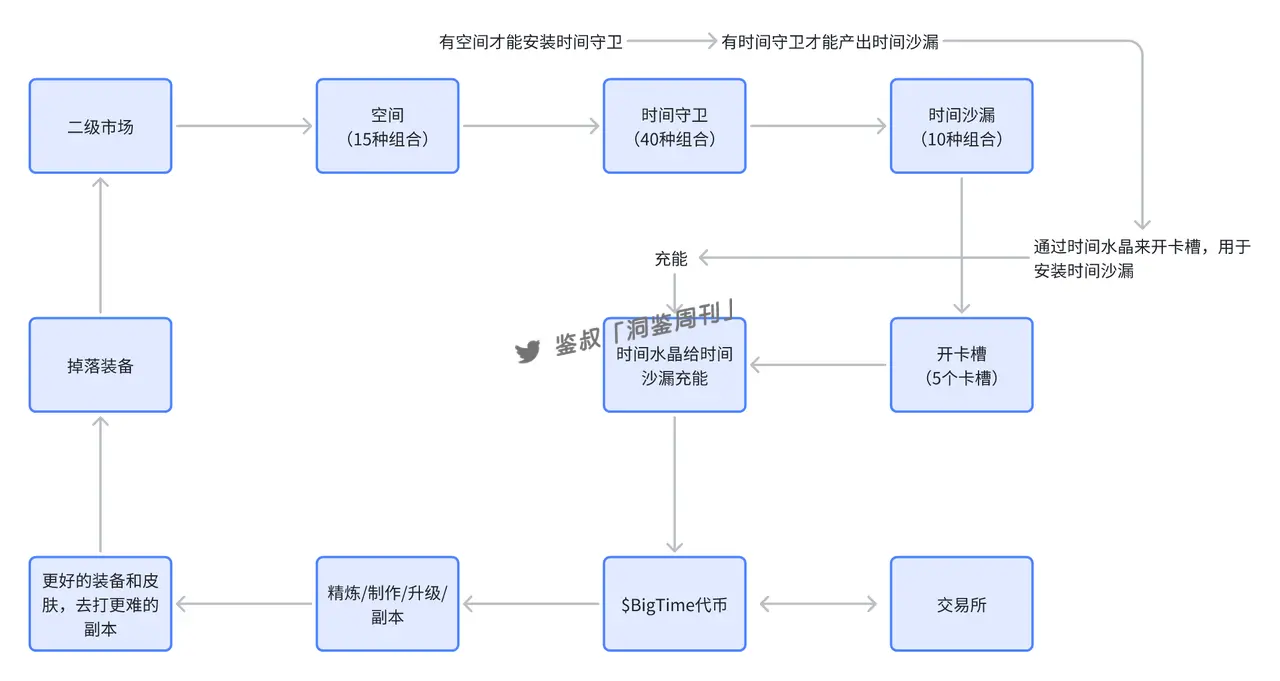
2. Player Type Balance
BigTime divides players into four main types: regular players, gold players, landlords, and big spenders, with different branches for gold players.
Regular players: Focus on experiencing game content, including non-paying players, and are more concerned about game playability.
Gold players: Focus on earning income, earn NFTs and tokens through the game and sell them, and do not care about playability.
Landlords: Balance game playability and gold income, earn income by renting out NFTs.
Big spenders: Value game content and fun, and gain more recognition and emotional value through the game.
BigTime adapts the game experience for different player types to achieve a closed loop, allowing gold players to focus solely on gold-making, big spenders to enjoy the game while consuming the output of gold players, regular players to act as a lubricant for the game, indirectly injecting liquidity into the game, and landlords to rent out equipment to meet the needs of different players. Ultimately, the game brings honor to big spenders, entertainment to regular players, and income to gold players.
With the emergence of different gold merchants, the current shortcomings of the game are also quite obvious. For example, there are almost no equipment merchants at present, because there are not enough real big spenders in the game, resulting in slow operation of the overall skin economy and low consumption. Although the necessary time guardians and hourglasses for gold-making have been intervened by the official, the prices are still high, leading to significant differences in asset prices. At the same time, the consumption of $BIGTIME tokens (single currency) and crystals (gold standard) is insufficient, and the application scenarios are not diverse enough.
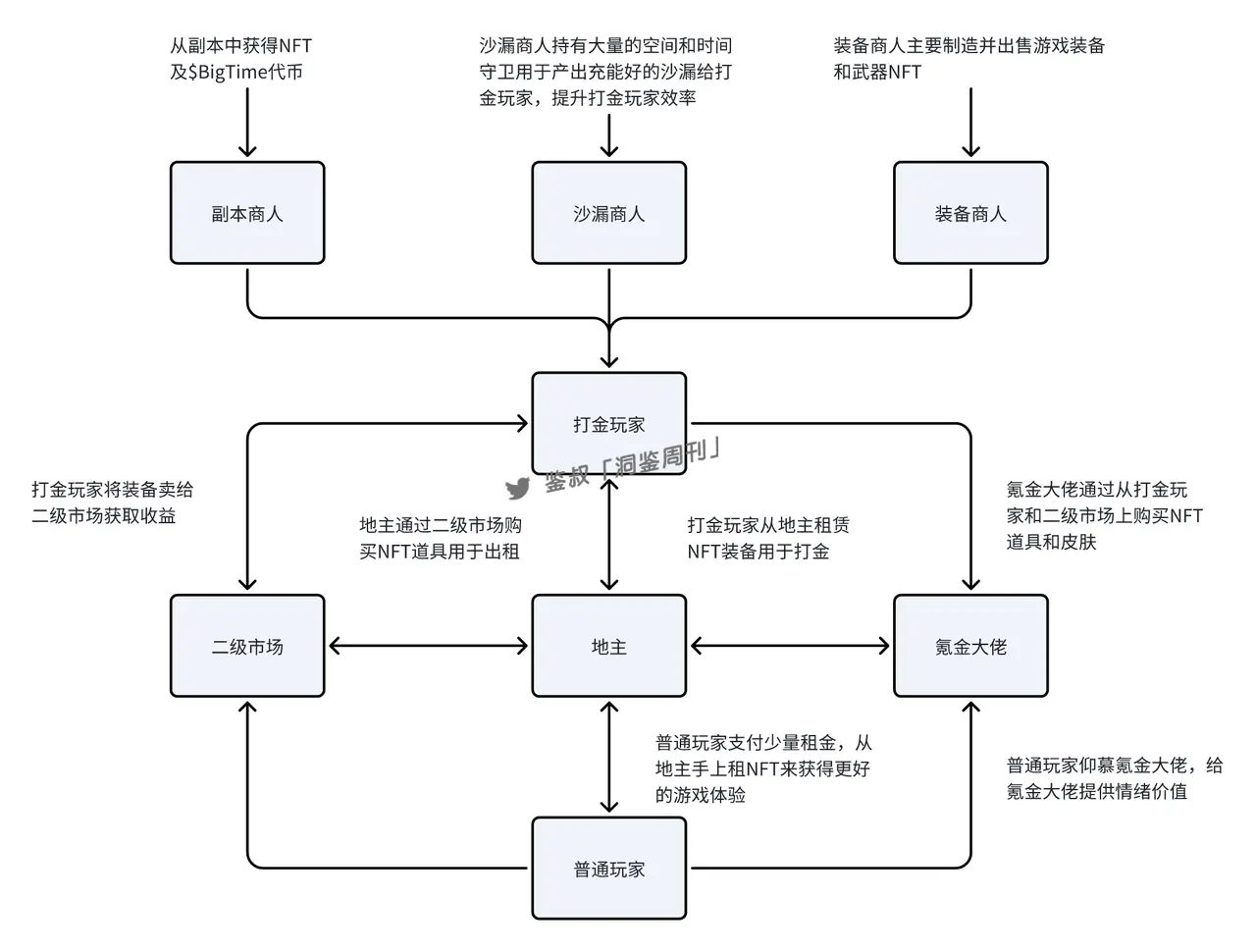
The leasing system, in a sense, is a form of pledging and borrowing, namely, DeFi gameplay. Many game developers now believe that instead of pledging tokens, it is better to pledge NFTs, which can also reduce market circulation, effectively pledging. In a stable market, long-term stable rental income will make players unwilling to sell NFTs, achieving the purpose of locking positions. However, for gold players, obtaining weapon equipment at low prices will further lead to a decline in gold income, which needs to be resolved through natural market regulation and official intervention.
In summary, the leasing system can allow NFT lessors to achieve the goal of indirect locking, but it is extremely dependent on the long-term stability of market prices. If the market cannot stabilize, there is a high possibility of a death spiral. The following figure illustrates the ideal income situation.
3. Strong Centralized Control
Strong centralized control mainly manifests in the game developer's macroeconomic control of the game. Frequent short-term control may cause many players to be resentful, but from a long-term perspective, it may be beneficial to the game.
At the beginning of the season, the official found that due to the extremely low cost of charging time hourglasses, a large number of time guardians were producing time hourglasses, leading to serious overproduction of time hourglasses in the short term. The official intervened in a timely manner, increasing the cost of charging hourglasses to balance the role of time guardians. However, this event also led to the emergence of time merchants, who specialize in selling hourglasses. Subsequently, due to the fact that time guardians are key functional NFTs for producing $BIGTIME tokens, someone monopolized the business, causing the lowest-level time guardians to rise tenfold in the short term. After noticing this, the official intervened again, controlling NFT prices by increasing airdrop amounts and drop rates. Transparency is key for strong centralized control. The BigTime official statement indicates that all $BIGTIME tokens can only be produced through the game, and there will be no possibility of massive unlocking.

II. Big Time Economic Model Analysis
Skins:
For many traditional Web2 games, players must recharge to purchase desired skins and items, which also means that most game skins and items cannot be resold. This operation mode prevents many players from cashing out their items. If they want to sell, they can only sell their accounts, but the value will be greatly devalued. For game developers, this one-size-fits-all approach also reduces the possibility of inflation to a certain extent.
For BigTime, the game focuses more on the development of the skin system, with a trading model similar to csgo. Taking csgo as an example, players pay fiat currency to obtain weapon cases and keys, and then use the weapon cases to draw different levels of game skins, which can be cashed out on off-platform platforms. This has also led to a market focused on csgo trading, such as Netease's buff.
BigTime mainly produces NFT skins through in-game arsenals/time guardians, and the produced skins are limited and will never increase. At the same time, NFT skins can be freely traded on the chain in the game, and different NFT skins will also allow players to access exclusive dungeon content, but without affecting balance.

NFT:
BigTime can be divided into two types of NFTs, namely skin NFTs and functional NFTs. Skin NFTs are purely decorative, with no bonuses and guaranteed balance. Their role is to increase user stickiness, ensure the gaming experience of big spenders and skin merchants, and showcase player status. Functional NFTs are production tools, mainly used to maintain the operation of BigTime and produce $BigTime tokens.
Skin NFTs can also be divided into two categories: manufacturable skins and non-manufacturable skins.
- Manufacturable skins: Mainly generated through arsenals and furnaces, with ten rarities in total, with higher rarities indicating more exquisite skins.
- Non-manufacturable skins: Can only be obtained through monster drops and dungeon drops, such as space decorations, weapons, armor, titles, and sound effects, with different rarities. Non-manufacturable skins can be obtained through dungeon drops or purchased in the secondary market.
Space:
Space is BigTime's private virtual land, akin to a player's home in the game. Space allows players to expand their personal metaverse and install skins. For gold players, space has two main functions:
1. Space can obtain shattered time hourglasses. 2. Install functional NFTs such as furnaces, arsenals, time guardians.
In essence, for players who want to experience BigTime and make money, space is a necessity, as only by owning space can they generate $BIGTIME tokens and earn income. Space is mainly divided into small, medium, and large sizes, each with 5 levels and different supply levels. Larger spaces can accommodate more functional NFTs and more decorations and equipment. Different space levels also have different probabilities of dropping shattered time hourglasses, with rarer spaces having a higher probability of dropping shattered time hourglasses. Additionally, higher rarity functional NFTs can only be connected to higher rarity spaces.
Space can be obtained through secondary market trading and random drops in dungeons and enemy encounters, but the probability is extremely low.
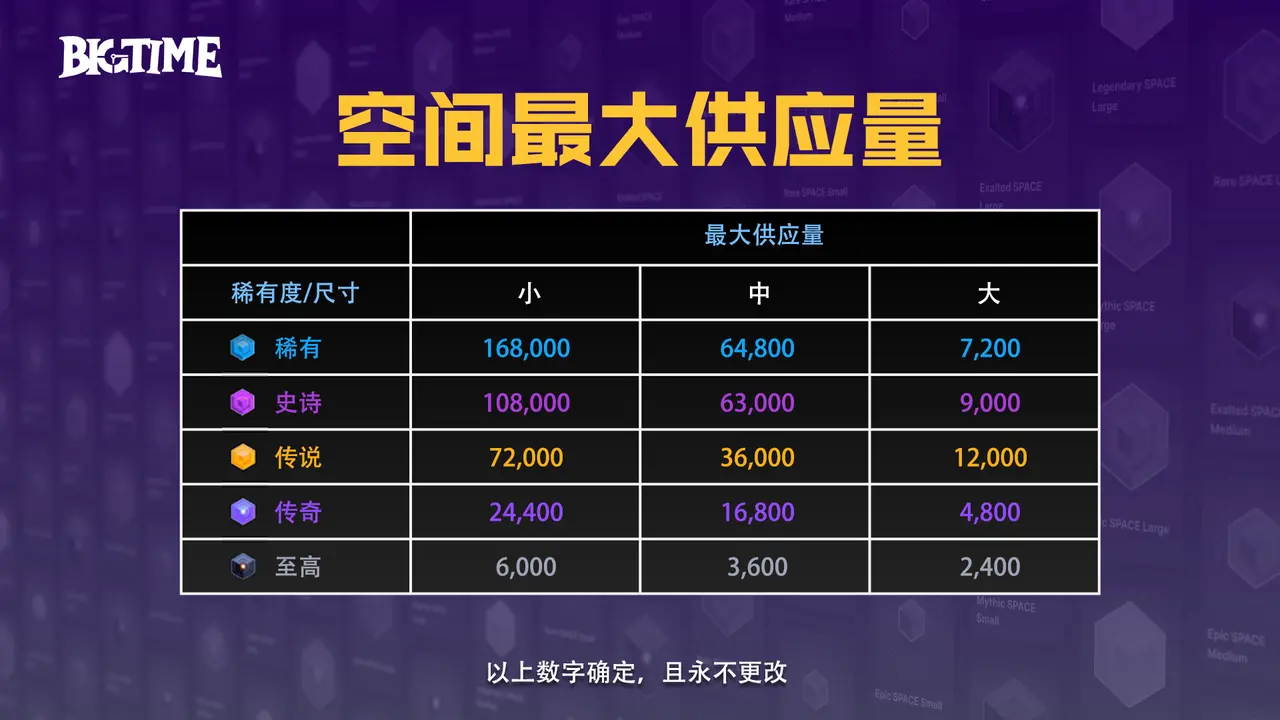
Functional NFTs:
Functional NFTs mainly include furnaces, arsenals, and time guardians, which are important components of BigTime and essential equipment for gold players. The time guardian's main function is to produce $BIGTIME tokens, while furnaces and arsenals consume $BIGTIME tokens to create skin NFTs.
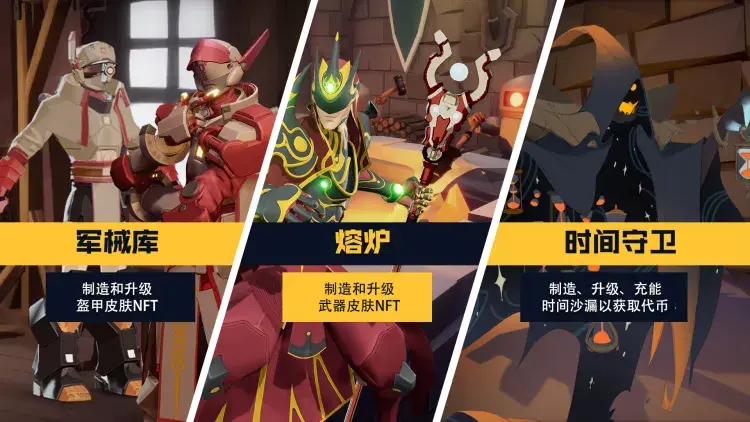
Functional NFT 1: Furnace
As a functional NFT, the furnace is mainly used to refine NFT weapon skin fragments, create, and upgrade weapon skins. The furnace has ten levels, from common to peerless, with different types having special rewards and colors. The furnace has 10 types, ranked from A to J, with different types providing special bonuses to different weapon skins. For example, a red A-type furnace can provide special bonuses to double-handed axe weapon skins, while a rainbow type can provide special bonuses to all weapon skins.
The furnace can only create or upgrade weapon skins that are within one level of its own rarity. In summary, the furnace has ten levels, ten types, and four colors, each providing different bonuses. Additionally, the furnace can be upgraded to improve its manufacturing capabilities.
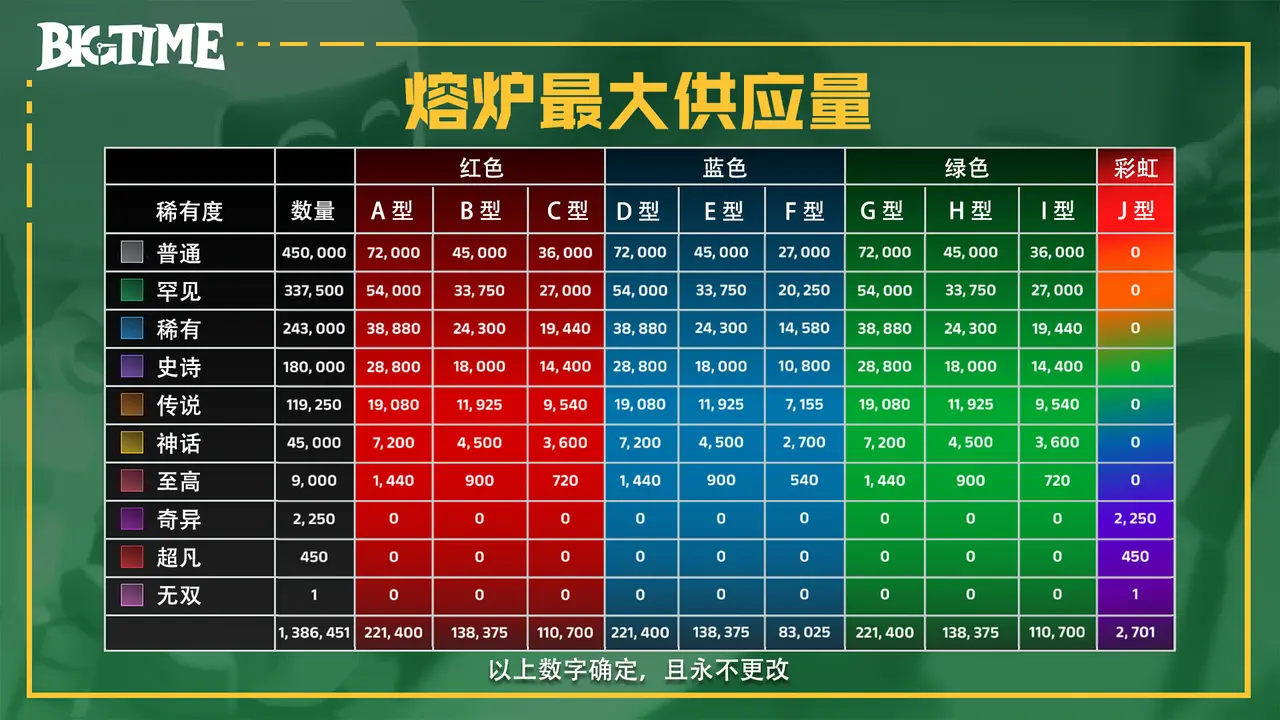
Functional NFT 2: Arsenal
The arsenal is mainly used to refine skin fragments, create, and upgrade armor skins. Similar to the furnace, the arsenal has ten levels, ten types, and four colors, each providing different bonuses. The arsenal can also be upgraded to improve its manufacturing capabilities.
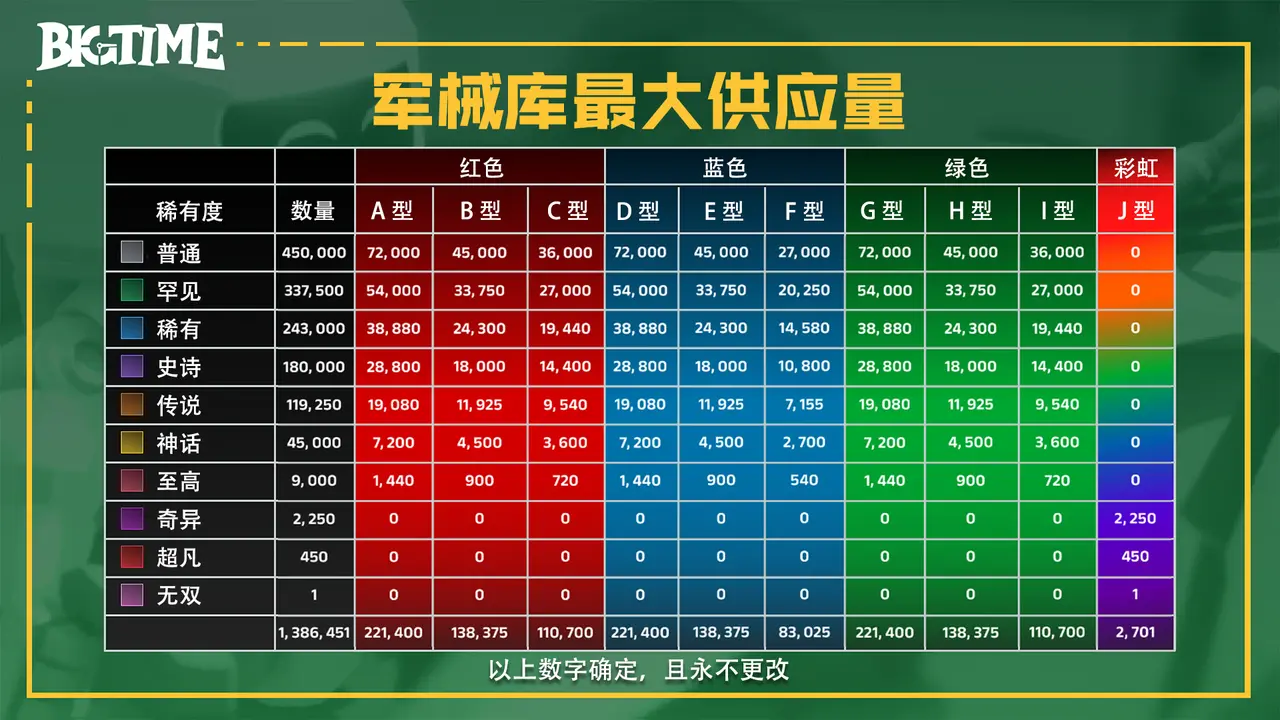
Functional NFT 3: Time Guardian
The time guardian is mainly used to create and replenish time hourglasses, which are divided into normal hourglasses and shattered hourglasses. Unlike the furnace and arsenal, the time guardian can only create and synthesize NFT items of the same or lower level. The time guardian has ten levels, four types, and four colors, each providing different bonuses.
Time Guardian can be used to create time hourglasses. Consuming $BIGTIME tokens and three time hourglasses can obtain a higher-level time hourglass, and it cannot be upgraded across levels. Different rarities of hourglasses require different time crystals and time to be consumed, with higher rarities requiring more. Time Guardian can also be upgraded through experience points, which can improve efficiency, unlock lucky bonuses, and more.
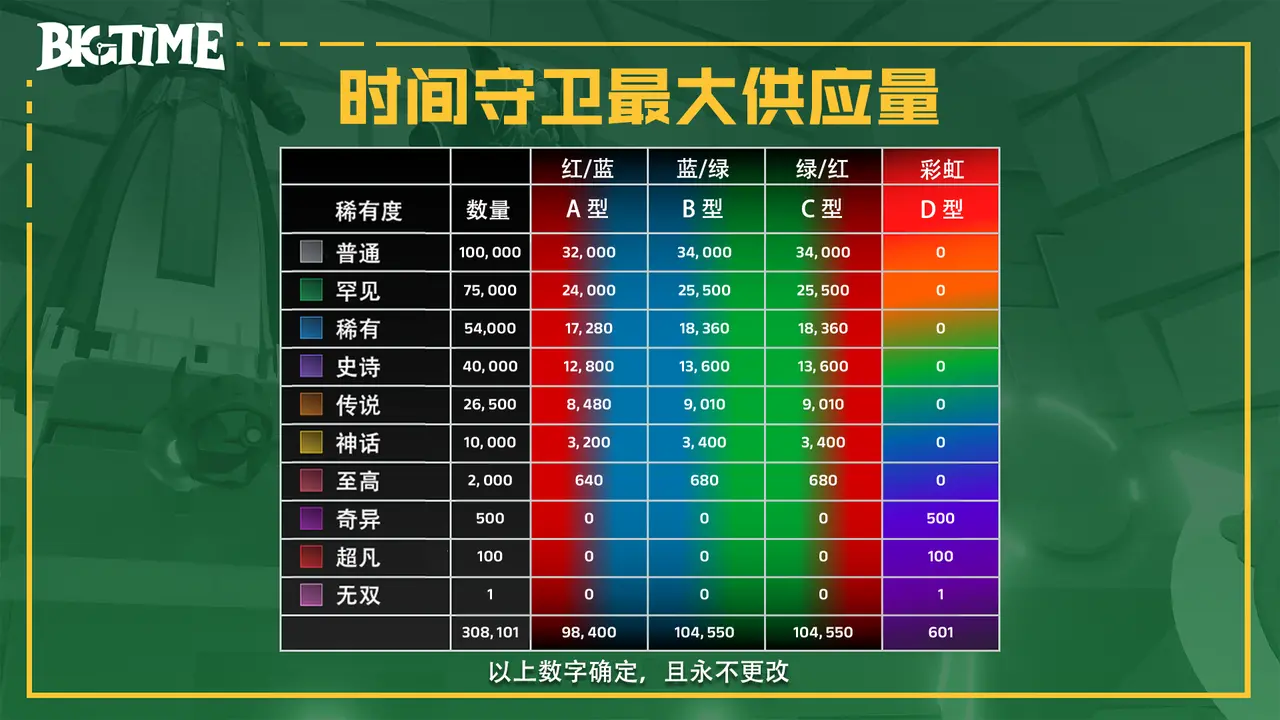
Hourglass
Hourglasses can be generated by the Time Guardian or purchased on the secondary market. Their main function is to obtain $BIGTIME tokens. Players can equip up to five hourglasses to maximize the production of $BIGTIME tokens. Players need to use time crystals to open slots to increase the number of hourglasses, with more slots resulting in higher costs.
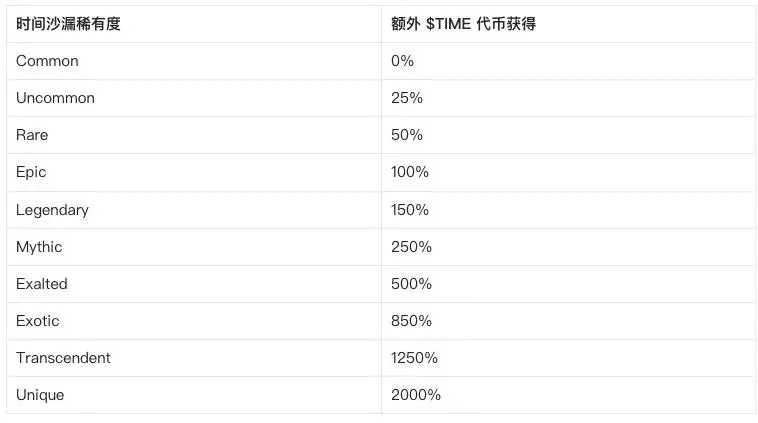
Hourglasses have ten levels, from common to peerless, with different rarities. The higher the rarity, the more $BIGTIME tokens are produced. Hourglasses will deplete their sand over time after being equipped, and once depleted, they cannot produce $BIGTIME tokens anymore. Players need to use time crystals to fill them up through the Time Guardian.
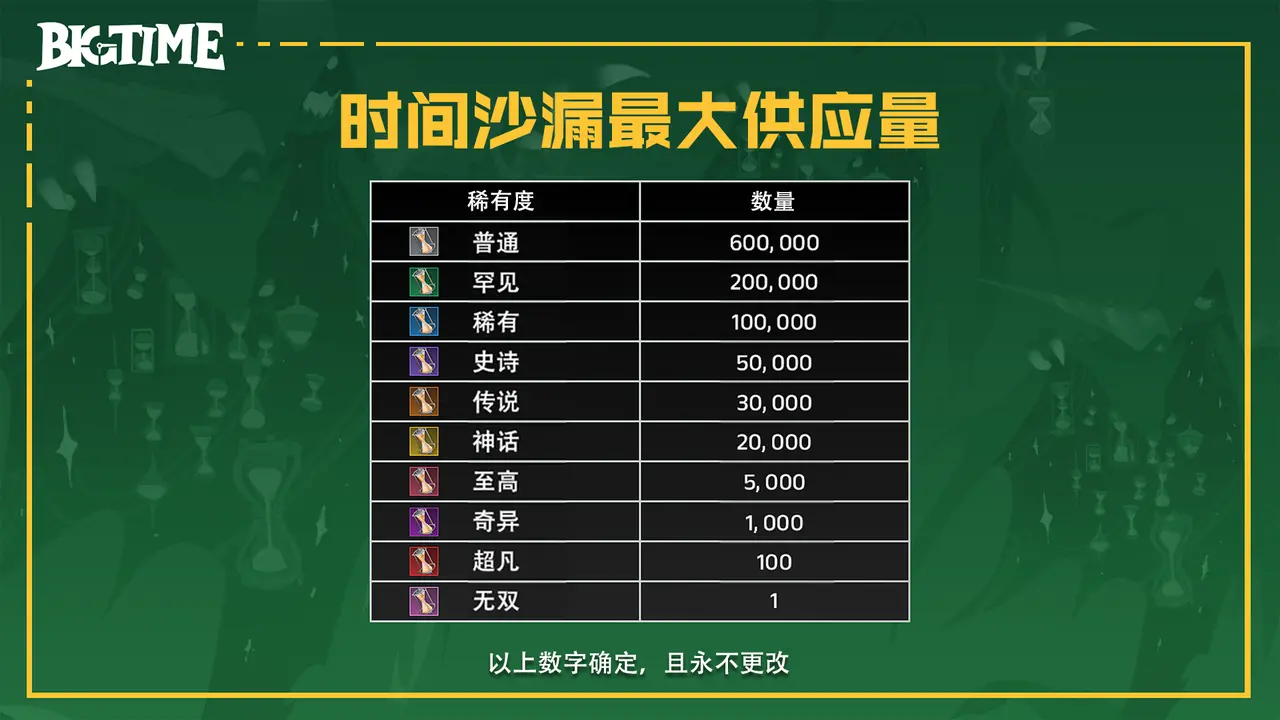
Cracked Hourglass
Cracked hourglasses are consumables, not NFTs, and can be equipped to obtain $BIGTIME tokens. However, once the sand is depleted, they will be automatically destroyed and cannot be traded. The size of the space connection determines the number of cracked hourglasses dropped, and the rarity of the space also determines the rarity of the cracked hourglass.

Summary:
Hourglasses can be purchased on the secondary market or created by the Time Guardian.
Cracked hourglasses cannot be purchased on the secondary market (non-NFT) and are randomly dropped through space.
The higher the rarity of the hourglass, the more $BIGTIME tokens are obtained.
Game Resources:
Time Crystals
Time crystals are not cryptocurrencies but are considered advanced currency in BigTime. They can be purchased with fiat currency on the secondary market or obtained through in-game drops (low probability). Time crystals are mainly used to charge hourglasses.
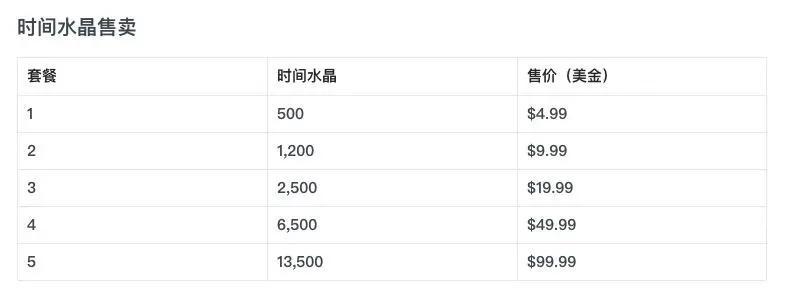
$BIGTIME Tokens
$BIGTIME tokens are the main cryptocurrency for the economic development of BigTime, with a maximum circulation of 5 billion. Players can earn $BIGTIME tokens by equipping time hourglasses and completing dungeons. The tokens are mainly used to refine, create, and upgrade NFTs, accelerate the production of functional NFTs, and access advanced dungeons.
Ways to obtain $BIGTIME tokens:
Players need to purchase space on the secondary market and then purchase a Time Guardian. The Time Guardian can produce time hourglasses, which need to be charged with time crystals. After the time crystals are fully charged, they need to be equipped in slots to produce $BIGTIME tokens.
Skin Fragments:
Skin fragments are basic materials for creating higher-level resources in the game. They can be obtained in the game or purchased on the secondary market. Skin fragments are mainly divided into three types:
Furnace skin fragments: Can be refined in the furnace.
Armory skin fragments: Can be refined in the armory.
Wild skin fragments: Can be refined in the furnace or armory.
The fragments change with the season, meaning new skin fragments are released each season.
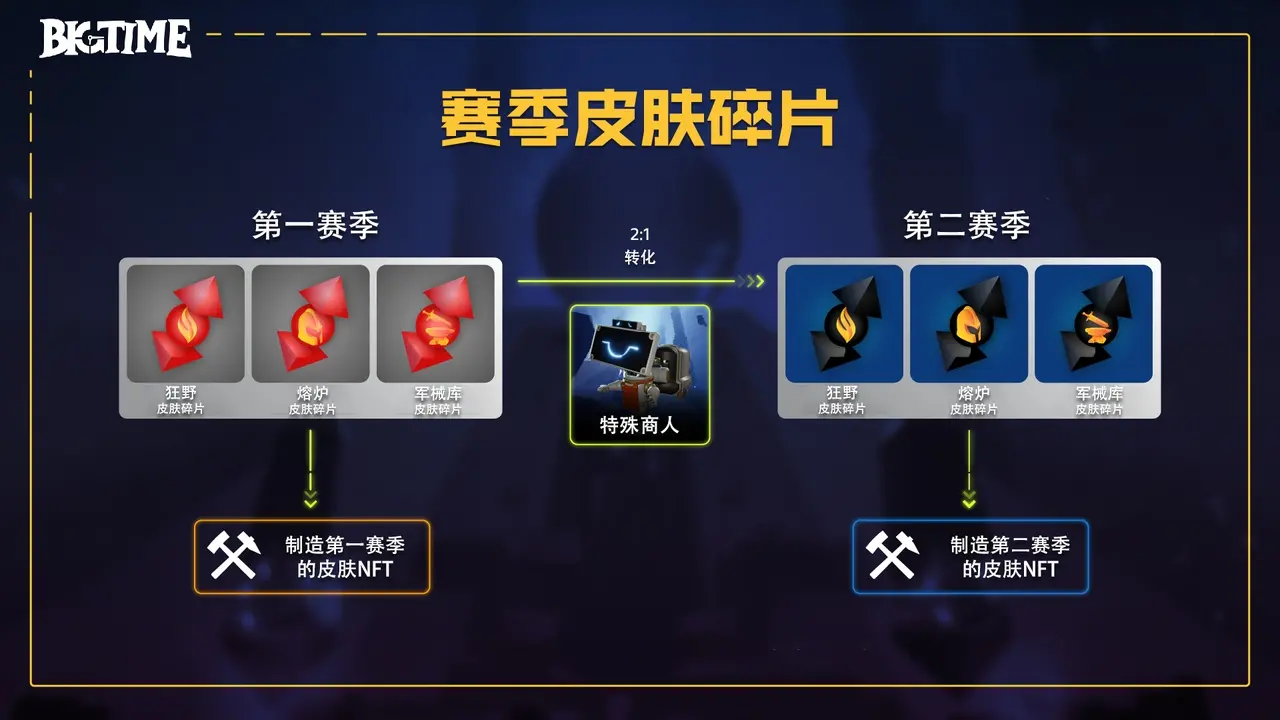
Refined Skin Fragments:
Refined fragments are mainly used to create and upgrade skins. They are also classified by function and season, with three levels: T1, T2, T3. The higher the level, the higher the level of the furnace and armory they can be used for creation and upgrade. They can be obtained through random drops in the game and on the secondary market.
Lucky Bonus Chips:
Lucky chips are used to increase a player's luck in the game and improve the output of specific activities. They are mainly divided into two types:
Workshop chips: Used for bonuses to functional NFTs.
Advanced portal chips: Used to improve the output of advanced dungeons.
Lucky bonus chips cannot be traded and can only be obtained through specific means, such as purchasing with time crystals or skin waste, or as rare drops in the game.
Skin Waste:
Resources obtained from dismantling skins, which cannot be traded and are mainly used to purchase lucky bonus chips. The effect of dismantling and the amount of waste produced are determined by the rarity of the skin.
III. Analysis and Prospects
Current drawbacks of blockchain games:
Returning to the initial outlook for blockchain games, why is Play to Earn a false proposition? Ultimately, it is because current Web3 games are not fun. Compared to Web2 games, the barrier to entry has increased, and the games are more difficult to play. If players want to have fun, why play them? In the current blockchain game market, we believe that development is still in its early stages. The initial success of Axie has shown the potential of blockchain games, but it seems that everyone has only focused on Play to Earn, and perhaps only by breaking out of the Earn circle can games develop better.
GameFi tokens need to have a certain application scenario, but many tokens are only useful in their own games and have no use elsewhere. In contrast to Web2 games, the vast majority of investment in Web2 games is in research and development. Some top games are even willing to spend billions to create games that are more fun and realistic, because for Web2 games, only by making the game good can users increase and the game survive. On the other hand, in Web3 games, most of the investment is in marketing, because for many projects, simply issuing tokens and airdrops can make money, so why spend money on game development?
Therefore, we cannot help but think, the game community can be divided into project parties and users. Project parties make games to make money, and users play games to make money, so who are they making money from together?
Future prospects:
We believe that games must provide players with non-financial/non-monetary experiences, not just focus on earning, but return to the essence of the game itself. The combination of social interaction and fun game experiences may be the key to whether a game can succeed, whether it is a Web3 game or a Web2 game. Taking StepN as an example, its success lies in opening up a new way to play blockchain games, making people realize that Play to Earn can be played in this way, turning play into running and exercise, and adding additional benefits such as health to the purely financial returns, making a breakthrough in the fun and playability of the game.
What is the "fun factor"?
The fun factor is the experience that brings joy, satisfaction, and fun to players while playing games. For example, the feeling of catching a rare fish in Animal Crossing, or opening a gold skin in csgo, or finally defeating a boss after practicing hard for days in Sekiro. These are all fun factors. It is because the design of these fun factors constantly triggers and exists in the game that players become more and more fond of and addicted to the game, leading them to actively spend money to consume in the game. ```
The Importance of Social Interaction in Games:
Looking at current Web3 games from the perspective of "Rate Tu Zhi Bin," it is evident that the majority of blockchain games overlook the importance of player interaction in social settings. Taking "Rate Tu Zhi Bin" as an example, its most important aspect is the social system.
"Rate Tu Zhi Bin" is an SLG game, and its key to success lies in its social attributes. In the game, if players want to move or attack others' territories, the most important thing is to join an alliance and gradually grow through the alliance and its battles. In the game, big spenders have more money but less time, mainly focusing on concentrating resources to confront others with strength, while regular players have less money but more time and can help pave the way for the alliance, ensuring that everyone has their own tasks. The existence of the alliance allows everyone to have a sense of belonging. In alliance battles, the leader needs to command everyone, which significantly increases the frequency of interaction in the game. It is this feeling of "if the alliance is here, I am here; if the alliance is not here, I am not here" that has captivated many people, with the camaraderie and brotherhood within the alliance being crucial. Similar games with this model include "Dream of Three Kingdoms," "Peace Elite," and "Egg Party," all of which bind players through social attributes and make them willingly recharge for the game.
In conclusion, a few years is not enough time for blockchain games to quickly find solutions and accomplish what Web2 games have achieved over decades. From the red and white machine in Japan to the current PS5, from GTA1 to GTA5, from Pac-Man to Red Dead Redemption 2, the entire market has undergone numerous rounds of iteration and development. Web3 games are still in a very early stage, and although the road is rough, the future is still bright.
IV. Basic Information of BigTime
BigTime officially started testing in April 2022 and is an MMORPG game similar to World of Warcraft and Diablo. Compared to Web3 games, it has finer graphics and better gameplay and experience.

Team:
The development team comes from game production companies such as Fortnite, Call of Duty, and League of Legends, with extensive experience in game production.
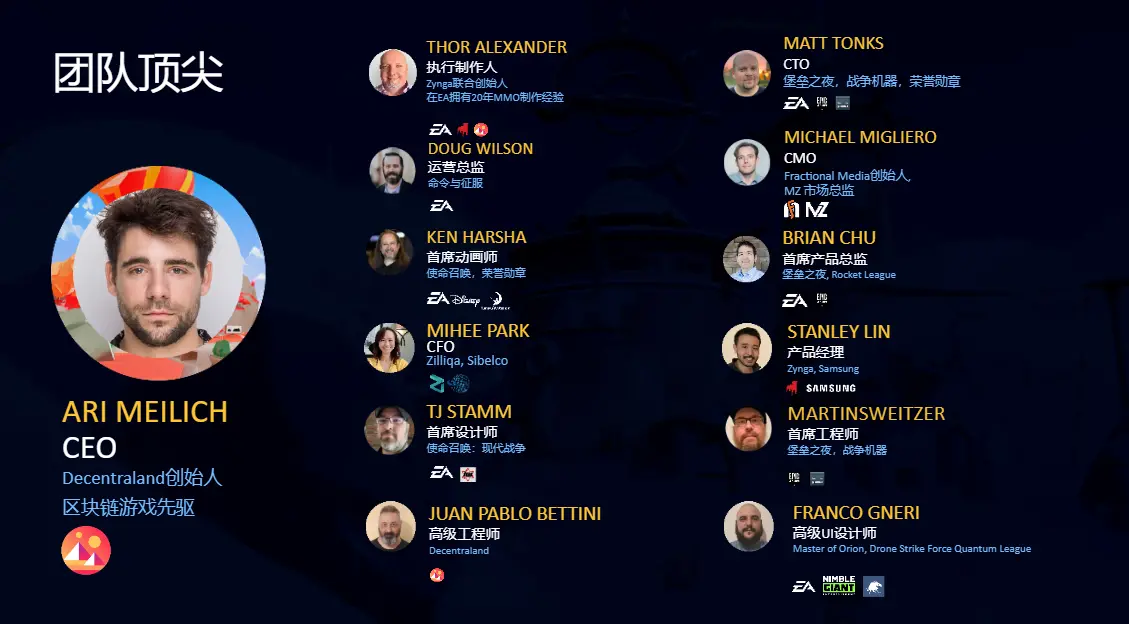
Financing:
In May 2021, the game completed a $21 million financing round, led by FBG Capital. In March 2022, BigTime completed two NFT sales, and in December, it completed a third sale, with total earnings reaching $70 million. After deducting operating costs, the team currently has nearly $90 million for game development.
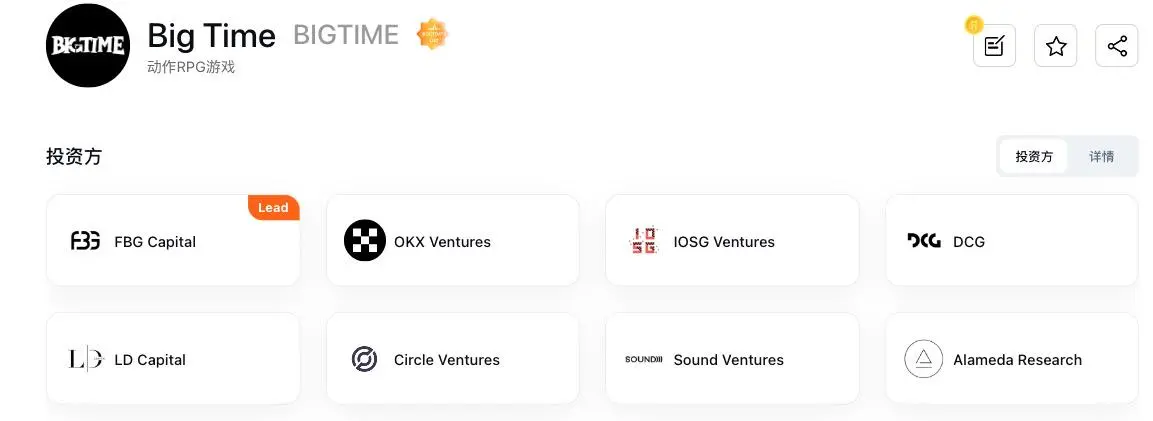
Token:
In October 2023, the game launched a complete economic model and issued $BIGTIME, which surged fivefold within a week, reaching a peak price close to $1.
Market Cap: $161 million
Price: $0.1786
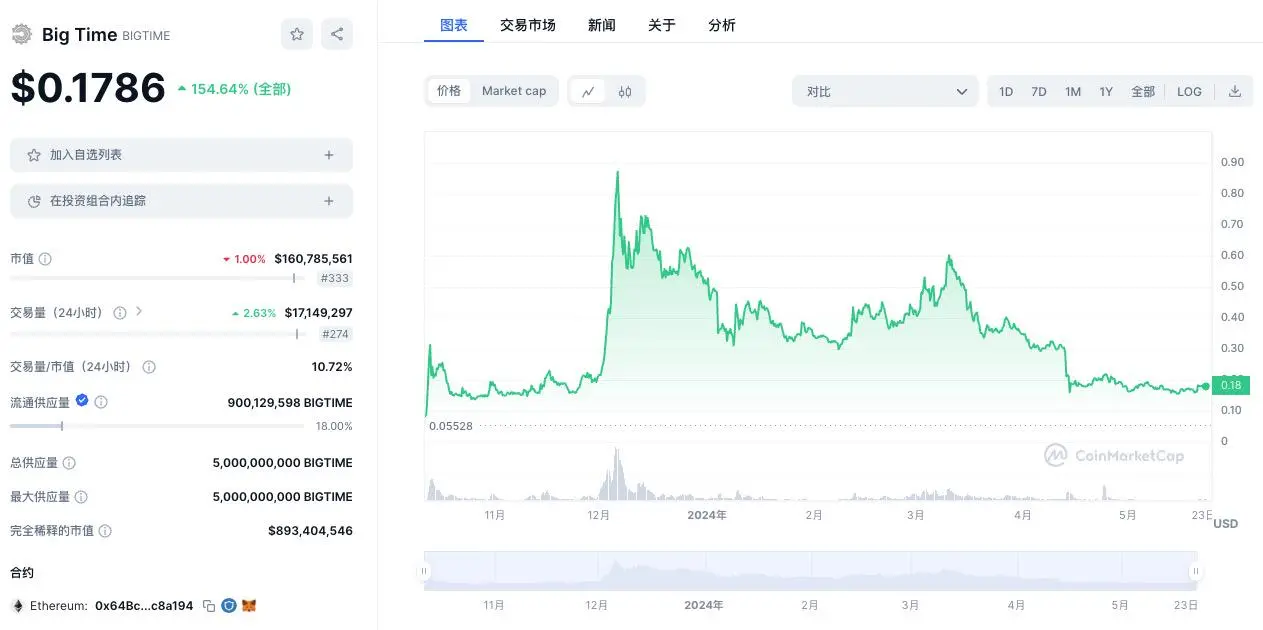
Threshold:
In terms of game requirements, the game does not require high computer specifications, but an invitation code is needed to enter, although it is relatively easy to obtain.
In terms of deposit thresholds, the game supports payment via bank cards and virtual currencies, and transactions can be made in the centralized official website store, with a low threshold.
In terms of login thresholds, the game only requires an email login, without the need to connect a wallet, providing a good experience for Web2 players transitioning to the game.
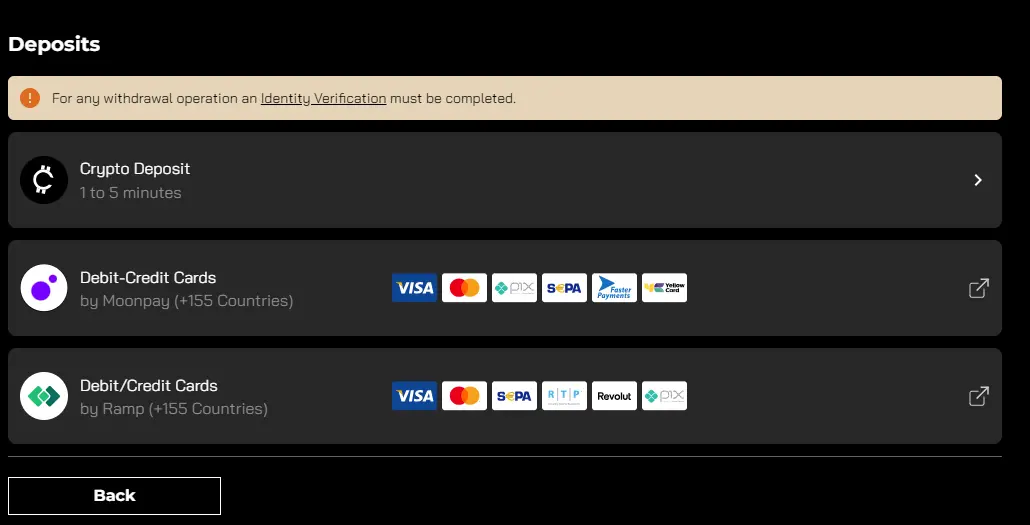
Reference:
https://www.chaincatcher.com/article/2103308
https://mirror.xyz/iamwgg.eth/HAoZR4dbEEghw4ql7fEeaXLeAPGiRronSDjGCpMZC-4
https://zhuanlan.zhihu.com/p/589546502
https://mp.weixin.qq.com/s/_hHSgyBmk3TbmX8qRcOcHQ
https://wggdao-creators.notion.site/Gamefi-4a00654d87ae415fb7cfb564c53493ce
免责声明:本文章仅代表作者个人观点,不代表本平台的立场和观点。本文章仅供信息分享,不构成对任何人的任何投资建议。用户与作者之间的任何争议,与本平台无关。如网页中刊载的文章或图片涉及侵权,请提供相关的权利证明和身份证明发送邮件到support@aicoin.com,本平台相关工作人员将会进行核查。




